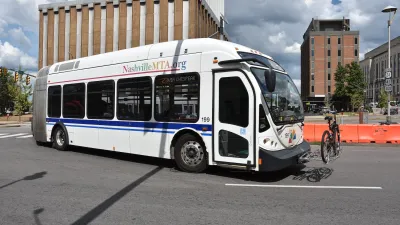Officials in Los Angeles were successful in implementing high-density growth policies to curb sprawl. However, a disconnect between culture, transportation policy, and the real estate market may have disastrous consequences.
Los Angeles real estate developers are pursuing high-density transit-oriented developments, similar to efforts in urban areas across the United States. However, the widespread availability of free parking, and lack of political momentum or support of public transportation, may cause these well-intentioned developments to create a city-wide traffic meltdown, instead of easing the region's long standing transportation woes.
"Six miles (10km) west of North Hollywood, a four-storey building is rising next to a car-wash on Ventura Boulevard. When finished, it will contain about 130 apartments and an underground car park. To an outsider it seems innocuous. To local residents, schooled by almost a century of strict zoning to believe that bedrooms must be separated from shops, it is anathema."
"Urban planners intone phrases like "transport-oriented development" and "elegant density". Yet nowhere has the dream of a house and a sun-drenched garden been so central to a city's identity for so long as in Los Angeles. So nowhere does the change come as such a shock."
"A big reason Angelenos drive everywhere is that they can park everywhere, generally free. Businesses must provide parking spaces according to a strict schedule. This raises the cost of doing business and hugely lowers the cost of driving."
FULL STORY: Tackling the hydra

Alabama: Trump Terminates Settlements for Black Communities Harmed By Raw Sewage
Trump deemed the landmark civil rights agreement “illegal DEI and environmental justice policy.”

Planetizen Federal Action Tracker
A weekly monitor of how Trump’s orders and actions are impacting planners and planning in America.

The 120 Year Old Tiny Home Villages That Sheltered San Francisco’s Earthquake Refugees
More than a century ago, San Francisco mobilized to house thousands of residents displaced by the 1906 earthquake. Could their strategy offer a model for the present?

In Both Crashes and Crime, Public Transportation is Far Safer than Driving
Contrary to popular assumptions, public transportation has far lower crash and crime rates than automobile travel. For safer communities, improve and encourage transit travel.

Report: Zoning Reforms Should Complement Nashville’s Ambitious Transit Plan
Without reform, restrictive zoning codes will limit the impact of the city’s planned transit expansion and could exclude some of the residents who depend on transit the most.

Judge Orders Release of Frozen IRA, IIJA Funding
The decision is a victory for environmental groups who charged that freezing funds for critical infrastructure and disaster response programs caused “real and irreparable harm” to communities.
Urban Design for Planners 1: Software Tools
This six-course series explores essential urban design concepts using open source software and equips planners with the tools they need to participate fully in the urban design process.
Planning for Universal Design
Learn the tools for implementing Universal Design in planning regulations.
Clanton & Associates, Inc.
Jessamine County Fiscal Court
Institute for Housing and Urban Development Studies (IHS)
City of Grandview
Harvard GSD Executive Education
Toledo-Lucas County Plan Commissions
Salt Lake City
NYU Wagner Graduate School of Public Service





























